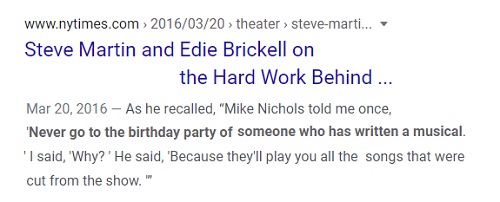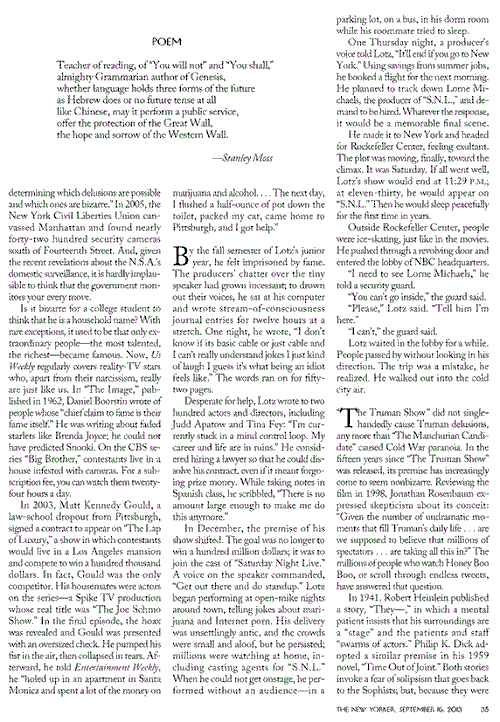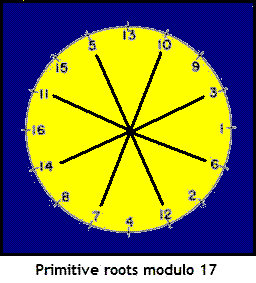|
The War to End All Wars (2018)
|
Tuesday, June 20, 2023
Annals of Devolution
Thursday, November 10, 2022
“What are we supposed to learn?”
From a search in this journal for "Hexagram 61" —
“‘Oracle, why did you write
The Grasshopper Lies Heavy?
What are we supposed to learn?'”
— Philip K. Dick
“She began throwing the coins.“
Click to enlarge.
Saturday, February 5, 2022
Hexagram 61 Revisited
The online New York Times today reporting a Jan. 29 death:
"Mr. Dylan asked Mr. Lay to back him on the title track
of his album “Highway 61 Revisited.” In addition to
playing drums, Mr. Lay played a toy whistle on the song’s
memorable opening."
— Richard Sandomir, Feb. 5, 2022, 2:06 p.m. ET
The above link yields a March 11, 2019, YouTube upload:
Some may prefer the theology of Hexagram 61.
“‘Oracle, why did you write
The Grasshopper Lies Heavy?
What are we supposed to learn?'”
— Philip K. Dick
“She began throwing the coins.“
Other remarks from the above
YouTube upload date — March 11, 2019 —
Monday, January 18, 2021
Thursday, March 26, 2020
Line for a National Comedy Center
Log24 last Sunday:
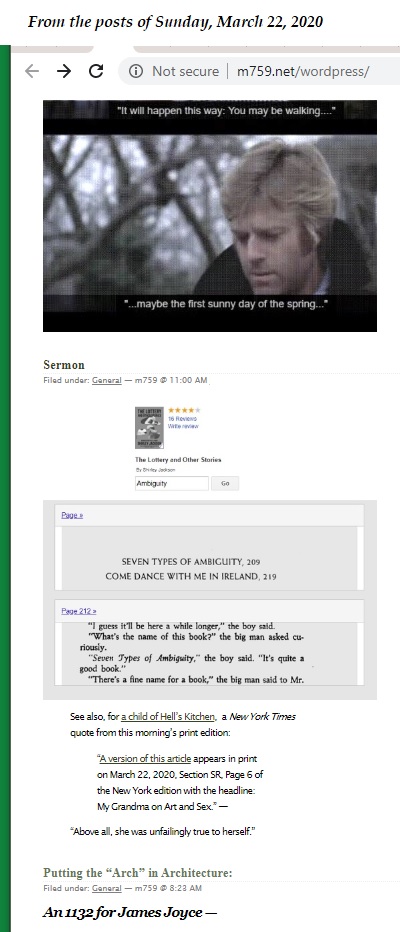
Two years earlier —

Saturday Night Live on March 24, 2018 (a repeat) —

Related literature: The 1953 Philip K. Dick story
“Paycheck” —
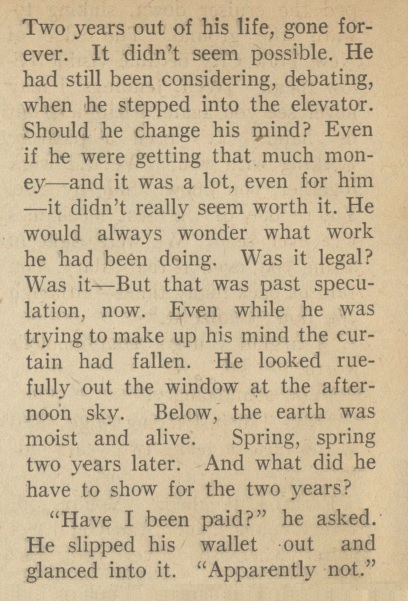
A punchline for Saoirse —
“Manly, yes, but I like it too.”
Saturday, July 27, 2019
Make America Strange Again
Suggested by the previous post, "The Swarm" —
“‘Oracle, why did you write
The Grasshopper Lies Heavy?
What are we supposed to learn?'”
— Philip K. Dick
“She began throwing the coins.“
Tuesday, September 10, 2013
Moss on the Wall
The following page from the Sept. 16, 2013, issue of The New Yorker
deals with current trends in paranoid schizophrenia. It may interest
fans of Philip K. Dick.
(Click for a larger, clearer image.)
As for the poem by Stanley Moss on the above page (35, by the way),
a quote from Wallace Stevens seems appropriate —
"It was a language he spoke, because he must, yet did not know.
It was a page he had found in the handbook of heartbreak."
For the "wall" theme of Moss, see (for instance), this journal
on June 3, 2013 — New Yorker Art.
"All in all…." — Pink Floyd
Friday, March 29, 2013
The Dreaming Jewels (continued)
In Memoriam
"In the late ’60s, Williams became a friend and confidant
of science fiction writer Philip K. Dick and wrote about
the iconoclastic author in Rolling Stone in 1974.
Williams eventually completed a biography on Dick
and became his literary executor after the writer’s death
in 1982. He also edited The Complete Stories of
Theodore Sturgeon, Vol. I-XII ."
— Yesterday in the Hollywood Reporter —
Pioneering Rock Journalist Paul S. Williams Dies at 64
4:06 PM PDT 3/28/2013 by Mitch Myers
See also Crawdaddy Story and The Dreaming Jewels
in this journal.
Related reading: Yesterday's noon post and Puzzles.
Update of 8:20 AM Good Friday, 2013:
Wednesday, May 23, 2012
Now What?
(Rhetorical question on the NY Times online front page,
10:01 PM May 23, 2012, in teaser for "The Stone" column
about Philip K. Dick, "Sci-Fi Philosopher")

Perhaps The Last Airbender ?

The NY Times philosophy column "The Stone" is currently about gnosticism
and science fiction.
The Last Airbender is about an avatar who is master of the four elements
air, water, earth, and fire. For a more sophisticated approach to gnosticism
and the four elements, see Irenaeus: Against Heresies.
See, too, Elements Diamond in this journal.
Saturday, March 3, 2012
Big Art
For Women's History Month—
The Beam of Pink Light
From a post linked to on Lyxe's upload date, Feb. 6, 2012—
“… with primitives the beginnings of art, science, and religion
coalesce in the undifferentiated chaos of the magical mentality….”
— Carl G. Jung, “On the Relation of Analytical Psychology to Poetry,”
Collected Works, Vol. 15, The Spirit in Man, Art, and Literature,
Princeton University Press, 1966, excerpted in
Twentieth Century Theories of Art, edited by James M. Thompson.
See also the NY Lottery for St. Luke's Day, 2011, publication date
of the new edition of Philip K. Dick's VALIS quoted above.
Monday, December 12, 2011
X o’ Jesus
Religion for stoners,♦ in memory of Horselover Fat
Amazon.com gives the publication date of a condensed
version* of Philip K. Dick's Exegesis as Nov. 7, 2011.
The publisher gives the publication date as Nov. 8, 2011.
Here, in memory of the author, Philip K. Dick (who sometimes
called himself, in a two-part pun, "Horselover Fat"), is related
material from the above two dates in this journal—
|
Tuesday, November 8, 2011 m759 @ 12:00 PM …. Update of 9:15 PM Nov. 8, 2011— From a search for the word "Stoned" in this journal—
See also Monday's post "The X Box" with its illustration
Monday, November 7, 2011
"Design is how it works." — Steve Jobs, quoted in
For some background on this enigmatic equation,
|
Merry Xmas.
♦ See also last night's post and the last words of Steve Jobs.
* Houghton Mifflin Harcourt, the publisher, has, deliberately or not, sown confusion
about whether this is only the first of two volumes.
Wednesday, July 13, 2011
The Dick Code
"Eighteenth century theories of language were often presented as genealogies; instead of looking to the functions or operations of language to describe its 'nature,' they appealed to the story of its origins (with more or less literalist intentions.) The interest in an original 'revealed' language began much earlier, however. Leibniz, for example, searched for a primitive root-language which he felt could be discovered through research into etymology, and asserted that this ur-text, whether its signifiers were natural or conventional, would be composed of rational relations worthy of its original author, or Author, that is, God. He also toyed with the notion that hieroglyphics might be a philosophical language, a kind of meaningful mathematics, whose revelations would be exact and necessary. The debate over the origins of language— and the status of hieroglyphics— as it played out in the eighteenth century was linked to a dispute over metaphor, conceived as a 'primitive' mode of expression which preceded and was less nuanced and precise than the 'arbitrary' modern European languages. What is essential here is not the specifics of the debate on the origins of language (although this would certainly add much to the present inquiry) but rather the link that was thus constituted between hieroglyphics, the primitive ('the savage and the poet speak only in hieroglyphics') and the idea of an archaic language as an original archive of meanings which pre-exists Man and his derivative or arbitrary tongues."
— "This Extreme and Difficult Sense of Spectacular Representation: Antonin Artaud's Ontology of 'Live'," by Deborah Levitt
^
"In several programming languages, such as C, C++, C#, Java, Perl, and Python, a caret (^) is used to denote the bitwise XOR operator. This is not used outside of programming contexts because it is too easily confused with other uses of the caret." —Wikipedia article on Exclusive Or
See also the above date, July 7, 2010, in this journal.

Philip K. Dick, author of the novel
on which the Harrison Ford film
"Blade Runner" (1982) was based.
"You'd never know it, but buddy
I'm a kind of poet."
Sunday, September 26, 2010
Where Credit Is Due…
The Dick Medal
Review of the film "Knowing" from 2009—
Nicolas Cage's character, an astrophysicist, looks at a chart (written 50 years earlier by a child) with a colleague and points out a chronologically correct prediction of the date and number of dead in world wide tragedies over the last fifty years, and his colleague's response is "Systems that find meaning in numbers are a dime a dozen. Why? Because people see what they want to see." Well that would be a pretty neat trick. You could build a career on that in a Vegas showroom.
Film Title: Next
Based on the 1954 short story
"The Golden Man" by Philip K. Dick
Release Date:
April 27, 2007
About the Film:
Nicolas Cage stars as Cris Johnson, a Las Vegas magician with a secret gift that is both a blessing and a curse: He has the uncanny ability to tell you what happens next.
Related material from this journal on the release date of "Next"— April 27, 2007—
|
Production Credits: Thanks to the
– and to
|
"It’s almost enough to make you think that time present and time past might both be present in time future. As someone may have said."
— David Orr, "The Age of Citation"
Thursday, June 4, 2009
Thursday June 4, 2009
The Grasshopper
Lies Heavy

“‘Oracle, why did you write
The Grasshopper Lies Heavy?
What are we supposed to learn?'”
— Philip K. Dick
“She began throwing the coins.“
Click on image
for further details.
Tuesday, August 14, 2007
Tuesday August 14, 2007
1928 – 1982
on the cover of
a 1987 edition of
his 1959 novel
Time Out of Joint:

Cover art by Barclay Shaw reprinted
from an earlier (1984) edition
Philip K. Dick as a
window wraith (see below)
"… the kind of guy who can't drink one cup of coffee without drinking six, and then stays up all night to tell you what Schopenhauer really said and how it affects your understanding of Hitchcock and what that had to do with Christopher Marlowe."
— as well as by the illustrations of Gopnik's characterization in Kernel of Eternity, and by the following passage from Gopnik's 2005 novel The King in the Window:
"What's a window wraith?"
"It's someone who once lived in the ordinary world who lives now in a window, and makes reflections of the people who pass by and look in."
"You mean you are a ghost?!" Oliver asked, suddenly feeling a little terrified.
"Just the opposite, actually. You see, ghosts come from another world and haunt you, but window wraiths are the world. We're the memory of the world. We're here for good. You're the ones who come and go like ghosts. You haunt us."
Related material: As noted, Kernel of Eternity, and also John Tierney's piece on simulated reality in last night's online New York Times. Whether our everyday reality is merely a simulation has long been a theme (as in Dick's novel above) of speculative fiction. Interest in this theme is widespread, perhaps partly because we do exist as simulations– in the minds of other people. These simulations may be accurate or may be– as is perhaps Gopnik's characterization of Philip K. Dick– inaccurate. The accuracy of the simulations is seldom of interest to the simulator, but often of considerable interest to the simulatee.
The cover of the Aug. 20 New Yorker in which the Adam Gopnik essay appears may also be of interest, in view of the material on diagonals in the Log24 entries of Aug. 1 linked to in yesterday's entry:
"Summer Reading,"
by Joost Swarte
Monday, August 13, 2007
Monday August 13, 2007
Adam Gopnik in
The New Yorker of
August 20, 2007–
"… the kind of guy who can't drink one cup of coffee without drinking six, and then stays up all night to tell you what Schopenhauer really said and how it affects your understanding of Hitchcock and what that had to do with Christopher Marlowe."
Modernity: A Film by
Alfred Hitchcock:
"… the most thoroughgoing modernist design element in Hitchcock's films arises out of geometry, as Francois Regnault has argued, identifying 'a global movement for each one, or a "principal geometric or dynamic form," which can appear in the pure state in the credits….'" –Peter J. Hutchings (my italics)
Epilogue:
Adam Gopnik is also the author
of The King in the Window, a tale
of the Christian feast of Epiphany
and a sinister quantum computer.
For more on Epiphany, see
the Log24 entries of August 1.
For more on quantum computing,
see What is Quantum Computation?.
See also
the previous entry.
Saturday, June 16, 2007
Saturday June 16, 2007
Obituaries in the News
Filed at 7:10 a.m. ET
Samuel Isaac Weissman
ST. LOUIS (AP) — Samuel Isaac Weissman, a professor and chemist who helped develop the first atomic bomb as part of the Manhattan Project, has died. He was 94.
Weissman died Tuesday [June 12]….
From Log24
on Tuesday,
June 12:
Sky Fish

Illustration from
LOGOS
(May 17, 2007)

Photo by Richard Termine
Scene from "Behind the Lid"
(See the Log24 entries from
June 12, the date of
Weissman's death.)
From Ben Brantley's
review of "Behind the Lid,"
a quote from the author:
"Her life, her voice says,
was devoted to discovering
'the inside on the outside,
the outside on the inside.'"
Related material:
"They did it from
the inside to the outside.
And from the outside to the in.
And that profoundly
moved me then. It was…
it was the most important thing
that I ever experienced."
"The search/ For reality
is as momentous as/
The search for God."
It is the philosopher's search/
For an interior made exterior/
And the poet's search
for the same exterior
made/ Interior….
Tuesday, June 12, 2007
Tuesday June 12, 2007
Sky Fish

Illustration from
LOGOS
(May 17, 2007)
From an obituary in today's New York Times:
"Lee Nagrin, a noted Off Broadway performance artist… died Thursday in Manhattan. She was 78….
She formed her own company, the Sky Fish Ensemble, in 1979 and presented performance-art pieces that tended to unspool like fairy tales, filled with mysterious, archetypal imagery. Her own presence was mysterious, too, both on and off the stage, often conjuring up the sense of a keen-eyed, all-seeing, benign witch.
She created some of those images midperformance, as when she traced a landscape along brown paper that ringed the stage space of Silver Whale Gallery, where much of her work was performed.
For her last piece, 'Behind the Lid,' she collaborated with the puppeteer Basil Twist on a story in which a woman looks back on her life through a dream. Performances are this month at the Silver Whale."
LEE NAGRIN AND BASIL TWIST’S
BEHIND THE LID
Tuesday – Sunday @ 8PM
June 3rd – June 28th
Silver Whale Gallery
"Silver Whale Gallery (21 Bleecker Street) proudly announces the world premiere of BEHIND THE LID, a new play by playwright/performer Lee Nagrin and puppeteer/performer Basil Twist that chronicles a woman looking back on her life through a dream; her memories expand, open and reveal while an intimate audience of 18 will travel with her through this hand made world. Audience members are guided by a young familiar through this older woman's life and dreams. They experience layer upon layer of the life of an American artist – Lee Nagrin. Basil Twist creates the puppetry and performs.
Tickets for BEHIND THE LID are $40. To purchase tickets, please call Smarttix.com at 212-868-4444 or for more information visit www.leenagrin.com on the Internet."
From Log24
on June 7, the date
of Nagrin's death:
"… Packaging is unavoidable.
Facts rarely, if ever,
speak for themselves."
— Matthew C. Nisbet,
Assistant Professor
of "Communication,"
June 6, 2007
From the
New York Lottery
on June 7, the date
of Nagrin's death:
Another opening of
another show.
Thursday, June 7, 2007
Thursday June 7, 2007
From the May 6, 2007,
New York Times,
Charles McGrath on
Philip K. Dick:
His early novels, written in two weeks or less, were published in double-decker Ace paperbacks that included two books in one, with a lurid cover for each. "If the Holy Bible was printed as an Ace Double," an editor once remarked, "it would be cut down to two 20,000-word halves with the Old Testament retitled as 'Master of Chaos' and the New Testament as 'The Thing With Three Souls.'"
Click to enlarge.
As for "the thing with
three souls"–
Part I:
"Educate, Empower, Entertain"
— Motto of Yolanda King
Part II:
Three universities
(but not those of
Martin Myerson)–
Princeton, Harvard, Cambridge
Thursday, May 17, 2007
Thursday May 17, 2007
Logos
for
Yolanda King,
who died May 15,
the birthday of
L. Frank Baum:
Tin Man, Lion, Scarecrow
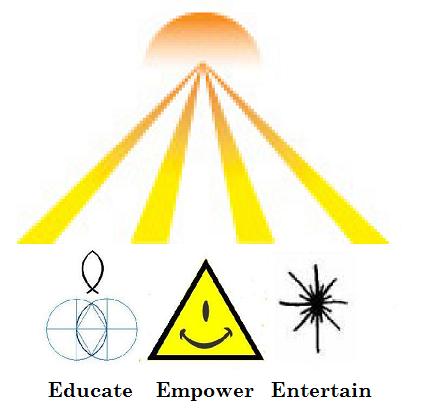
Symbols of, left to right,
Philip K. Dick (see 3/2/06),
Robert Anton Wilson (see 6/11/03),
and Kurt Vonnegut (see Palm Sunday,
an Autobiographical Collage).
See also An Unholy Trinity (5/6/07).
The "sunrise" logo at top,
along with the three-part motto
"Educate, Empower, Entertain,"
is Yolanda King's own.
Sunday, May 6, 2007
Sunday May 6, 2007
Three Souls
From today’s New York Times, Charles McGrath on Philip K. Dick:
His early novels, written in two weeks or less, were published in double-decker Ace paperbacks that included two books in one, with a lurid cover for each. “If the Holy Bible was printed as an Ace Double,” an editor once remarked, “it would be cut down to two 20,000-word halves with the Old Testament retitled as ‘Master of Chaos’ and the New Testament as ‘The Thing With Three Souls.'”
Now perhaps enjoying the afterlife together:
Thursday, March 2, 2006
Thursday March 2, 2006
John Updike in
The New Yorker:
“Birthday, death-day —
what day is not both?”
Annie Dillard in
For the Time Being:
“in and out of time”
Born on this date:
Died on this date:
Thursday March 2, 2006
continues…
“My father is, of course,
as mad as a hatter.”
— Diana Rigg in “The Hospital,”
as transcribed at
script-o-rama.com

“A vesicle pisces* is the name that author Philip K. Dick gave to a symbol he saw (on February 2**, 1974) on the necklace of a delivery woman.
PKD was probably conflating the names of two related symbols, the ichthys consisting of two intersecting arcs resembling the profile of a fish… used by the early Christians as a secret symbol, and the vesica piscis, from the centre of which the ichthys symbol can be drawn.”
Related material at Wikipedia:
Related material at Log24:
Related material elsewhere:
* Wikipedia’s earliest online history for this incorrect phrase is from 25 November, 2003, when the phrase was attributed to Dick by an anonymous Wikipedia user, 216.221.81.98, who at that time apparently did not know the correct phrase, “vesica piscis,” which was later supplied (16 February, 2004) by an anonymous user (perhaps the same as the first user, perhaps not) at a different IP address, 217.158.203.103. Wikipedia authors have never supplied a source for the alleged use of the phrase by Dick. This comedy of errors would be of little interest were it not for its strong resemblance to the writing process that resulted in what we now call the Bible.
** Other accounts (for instance, Divine Invasions: A Life of Philip K. Dick, by Lawrence Sutin, Carroll & Graf paperback (copyright 1989, republished on August 9, 2005), page 210) say Dick’s encounter was not on Groundhog Day (also known as Candlemas), but rather on February 20, 1974.
Sunday, June 6, 2004
Sunday June 6, 2004
|
From
The Man in the High Castle by Philip K. Dick Juliana said, “Oracle, why did you write The Grasshopper Lies Heavy? What are we supposed to learn?” “You have a disconcertingly superstitious way of phrasing your question,” Hawthorne said. But he had squatted down to witness the coin throwing. “Go ahead,” he said; he handed her three Chinese brass coins with holes in the center. “I generally use these.” She began throwing the coins; she felt calm and very much herself. Hawthorne wrote down her lines for her. When she had thrown the coins six times, he gazed down and said: “Sun at the top. Tui at the bottom. Empty in the center.”
“Do you know what hexagram that is?” she said. “Without using the chart?” “Yes,” Hawthorne said. “It’s Chung Fu,” Juliana said. “Inner Truth. I know without using the chart, too. And I know what it means.” From 12:5 … and the almond tree shall flourish, and the grasshopper shall be a burden, and desire shall fail: because man goeth to his long home, and the mourners go about the streets
|
Monday, November 17, 2003
Monday November 17, 2003
Total Recall:
in which Philip K. Dick
meets Joan Didion yet again
From Joan Didion’s new work on California history, Where I Was From:
“There was never just the golden dream of riches and bountiful nature, but always a scene of exploitation and false promises, indifference and ruthlessness, a kind of hollow core.”
 |
 |
Hollow no more.
Monday November 17, 2003
Inaugural Poem for California:
Archaischer Torso Apollos
by Rainer Maria Rilke
Wir kannten nicht sein unerhörtes Haupt,
darin die Augenäpfel reiften. Aber
sein Torso glüht noch wie ein Kandelaber,
in dem sein Schauen, nur zurückgeschraubt,
sich hält und glänzt. Sonst könnte nicht der Bug
der Brust dich blenden, und im leisen Drehen
der Lenden könnte nicht ein Lächeln gehen
zu jener Mitte, die die Zeugung trug.
Sonst stünde dieser Stein entstellt und kurz
unter der Schultern durchsichtigem Sturz
und flimmerte nicht so wie Raubtierfelle;
und bräche nicht aus allen seinen Rändern
aus wie ein Stern: denn da ist keine Stelle,
die dich nicht sieht. Du musst dein Leben ändern.
Illustration:
See also
Philip K. Dick Meets Joan Didion,
The Empty Center, and
Translation of Rilke by Stephen Mitchell:
Archaic Torso of Apollo
We cannot know his legendary head
with eyes like ripening fruit. And yet his torso
is still suffused with brilliance from inside,
like a lamp, in which his gaze, now turned to low,
gleams in all its power. Otherwise
the curved breast could not dazzle you so, nor could
a smile run through the placid hips and thighs
to that dark center where procreation flared.
Otherwise this stone would seem defaced
beneath the translucent cascade of the shoulders
and would not glisten like a wild beast’s fur:
would not, from all the borders of itself,
burst like a star: for here there is no place
that does not see you. You must change your life.
Saturday, November 15, 2003
Saturday November 15, 2003
From the
Empty Center:
|
From Friday's 2:56 AM entry —
Philip K. Dick,
"Sun at the top.
"Do you know "Yes," Hawthorne said.
"It's Chung Fu," Juliana said.
Margo Jefferson in
"When a classical text is modernized, |
Today's previous entry, "Aes Triplex," is actually from 1:48 PM EST yesterday. (It was posted to my alternate site, log24.com, since log24.net was down for Xanga maintenance.) "Aes Triplex" deals with image and reality.
Its final link, to the heart of Rome, leads to Julius Caesar.
A related review in today's New York Times:
"We live in a media maelstrom, and the Moonwork theater company's 'Julius Caesar' comes hurtling toward us right from its center. This production, at the Connelly Theater in the East Village through Nov. 23, is set in the here and now.
'Julius Caesar' is about politics, rhetoric and power; about manipulation of a nation's image and its people; about conspiracy, murder and the war that leads to a new regime. What play is better suited for our times?"
Saturday November 15, 2003
Aes Triplex
The title, from a Robert Louis Stevenson essay, means “triple brass” (or triple bronze):
From the admirable site of J. Nathan Matias:
“Aes Triplex means Triple Bronze, from a line in Horace’s Odes that reads ‘Oak and triple bronze encompassed the breast of him who first entrusted his frail craft to the wild sea.’ ”
From Philip K. Dick’s The Man in the High Castle:
Juliana said, “Oracle, why did you write The Grasshopper Lies Heavy? What are we supposed to learn?”
“You have a disconcertingly superstitious way of phrasing your question,” Hawthorne said. But he had squatted down to witness the coin throwing. “Go ahead,” he said; he handed her three Chinese brass coins with holes in the center. “I generally use these.”
This passage, included in my earlier entry of Friday, combined with the opening of yet another major motion picture starring Russell Crowe, suggests three readings for that young man, who is perhaps the true successor to Marlon Brando.
Oracle, for Crowe as John Nash (A Beautiful Mind):
Mutiny, for Crowe as Jack Aubrey (Master and Commander):
Storm, for Crowe as Maximus (Gladiator):
As background listening, one possibility is Sinatra’s classic “Three Coins”:
Personally, though, I prefer, as a tribute to author Joan Didion (who also wrote of coins and the Book of Transformations), the even more classic Sinatra ballad
“Angel Eyes.”
* Horace leads to “Acroceraunian shoals,” which leads to Palaeste, which leads to Pharsalia and to the heart of Rome. (With a nod to my high school Latin teacher, the late great John Stachowiak.)
Friday, November 14, 2003
Friday November 14, 2003
Philip K. Dick Meets Joan Didion
From the ending of
The Man in the High Castle:
Juliana said, “I wonder why the oracle would write a novel. Did you ever think of asking it that?” ….
“You may say the question aloud,” Hawthorne said. “We have no secrets here.”
Juliana said, “Oracle, why did you write The Grasshopper Lies Heavy? What are we supposed to learn?”
“You have a disconcertingly superstitious way of phrasing your question,” Hawthorne said. But he had squatted down to witness the coin throwing. “Go ahead,” he said; he handed her three Chinese brass coins with holes in the center. “I generally use these.”
She began throwing the coins; she felt calm and very much herself. Hawthorne wrote down her lines for her. When she had thrown the coins six times, he gazed down and said:
“Sun at the top. Tui at the bottom. Empty in the center.”

“Do you know what hexagram that is?” she said. “Without using the chart?”
“Yes,” Hawthorne said.
“It’s Chung Fu,” Juliana said. “Inner Truth. I know without using the chart, too. And I know what it means.”
From the ending of
Play It As It Lays:
I lie here in the sunlight, watch the hummingbird. This morning I threw the coins in the swimming pool, and they gleamed and turned in the water in such a way that I was almost moved to read them. I refrained.
One thing in my defense, not that it matters. I know something Carter never knew, or Helene, or maybe you. I know what “nothing” means, and keep on playing.
Why, BZ would say.
Why not, I say.
Friday, August 30, 2002
Friday August 30, 2002
For Mary Shelley, on her birthday: A Chain of Links The creator of Frankenstein might appreciate the following chain of thought. Lucifer.com Lucifer Media Corporation Lucifer Media Sites The Extropy Institute: International Transhumanist Solutions Why Super-Human Intelligence Would Be Equivalent To Precognition, by Marc Geddes:
"Consider the geometry of multiple dimensions as an analogy for mental abilities… …if there is a 4th dimension of intelligence, to us ordinary humans stuck with 3 dimensional reasoning, this 4th dimension would be indistinguishable from precognition. Post-humans would appear to us ordinary humans as beings which could predict the future in ways which would be inexplicable to us. We should label post-humans as 'Pre-Cogs.'
In the Steven Speilberg [sic] film Minority Report, we encounter genetically engineered humans with precisely the abilities described above."
Internet Movie Database page on "Minority Report"
IMDb page on "Minority Report" author Philip K. Dick
IMDb biography of Philip K. Dick, where our chain of links ends. Here Dick says that
"The basic tool for the manipulation of reality is the manipulation of words. If you can control the meaning of words, you can control the people who must use the words."
On the other hand, Dick also says here that
"Reality is that which, when you stop believing in it, doesn't go away."
These two quotations summarize, on the one hand, the cynical, relativistic nominalism of the postmodernists and, on the other hand, the hard-nosed realism of the Platonists.
What does all this have to do with "the geometry of multiple dimensions"?
Consider the famous story for adolescents, A Wrinkle in Time, by Madeleine L'Engle. The author, a well-meaning Christian, tries, like all storytellers, to control her readers by controlling the meaning of words. The key word in this book is "tesseract," a term from multi-dimensional geometry. She insists that a tesseract has mystic properties and cannot be visualized. She is wrong (at least about the visualizing).
See The Tesseract: A look into 4-dimensional space, by Harry J. Smith.
See also the many revealing comments in Harry J. Smith's Guestbook.
One of Smith's guests remarks, apropos of Smith's comments on St. Joseph, that he has his own connection with St. Augustine.
For a adult-level discussion of Augustine, time, eternity, and Platonism, see the website Time as a Psalm in St. Augustine, by A. M. Johnston.
See also the remark headlining Maureen Dowd's New York Times column of August 28, 2002, Saint Augustine's Day:
"I'm with Dick."
Whether the realist Dick or the nominalist Dick, she does not say.
As for precognition, see my series of journal notes below, which leads up to two intriguing errors in an Amazon.com site on the "Forbidden Planet" soundtrack. The first two audio samples from this soundtrack are (wrongly) entitled "Birdland" and "Flamingo." See also the West Wing episode rebroadcast on Wednesday, August 28, 2002,
C. J. Cregg (Allison Janney), who models a black Vera Wang dress in that episode, has the Secret Service codename Flamingo.
"…that woman in black She's a mystery She's everything a woman should be Woman in black got a hold on me"
(Foreigner 4 in my August 28 note below)




